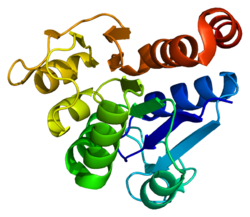Function
DJ-1 was shown to prevent metabolite and protein damage caused by a glycolytic metabolite. [12] This metabolite has been suggested [12] and confirmed [13] to be cyclic 3-phosphoglycerate (or cyclic 3-phosphoglyceric anhydride). Catalytic efficiency of DJ-1 as a hydrolase of cyclic 3-phosphoglyceric anhydride is 10,000 times higher than other reported enzymatic activities of DJ-1. [13]
Under an oxidative condition, DJ-1 inhibits the aggregation of α-synuclein via its chaperone activity, [14] [15] thus functioning as a redox-sensitive chaperone and as a sensor for oxidative stress. Accordingly, DJ-1 apparently protects neurons against oxidative stress and cell death. [5] In parallel, protein DJ-1 acts as a positive regulator of androgen receptor-dependent transcription. DJ-1 is expressed in both the neural retina and retinal pigment epithelium of mammals, where it exerts a neuroprotective role against oxidative stress under both physiological and pathological conditions. [16] [17]
Pyrroloquinoline quinone (PQQ) has been shown to reduce the self-oxidation of the DJ-1 protein, an early step in the onset of some forms of Parkinson's disease. [18]
Functional DJ-1 protein has been shown to bind metals and protect against metal-induced cytotoxicity from copper and mercury. [19]
DJ-1/PARK7 and its bacterial homologs: Hsp31, YhbO, and YajL can repair methylglyoxal and glyoxal glycated nucleotides. [20] Guanine, either in the form of a free nucleotide or as a nucleotide incorporated into nucleic acid (DNA or RNA), if glycated, can be repaired by DJ-1/PARK7. [20] Deglycase-deficient bacterial mutants with reduced ability to repair glycated bases in DNA show strong mutator phenotypes. [20] A follow up study confirmed that DJ-1 reduces levels of reversible adducts of methylglyoxal with guanine and cysteine in vitro. However, since the steady-state kinetics of DJ-1 acting on reversible hemithioacetal substrates are fitted adequately with a computational kinetic model that requires only a DJ-1 glyoxalase activity, it was concluded that deglycation is an apparent rather than a true activity of DJ-1. [21]
This page is based on this
Wikipedia article Text is available under the
CC BY-SA 4.0 license; additional terms may apply.
Images, videos and audio are available under their respective licenses.














